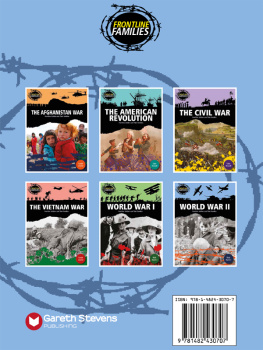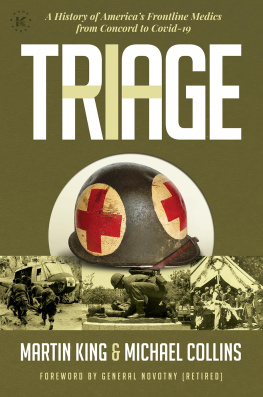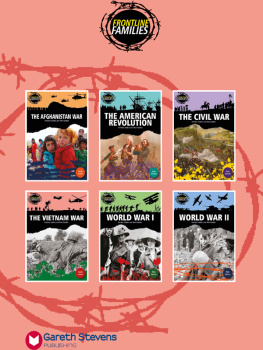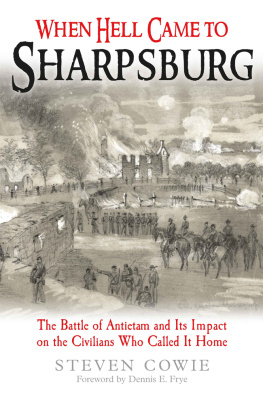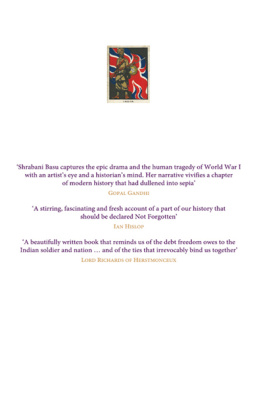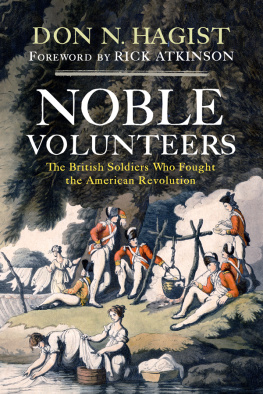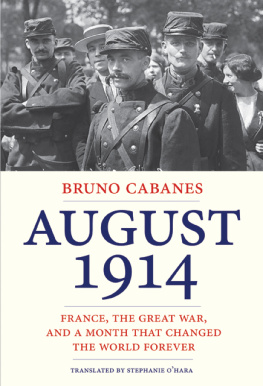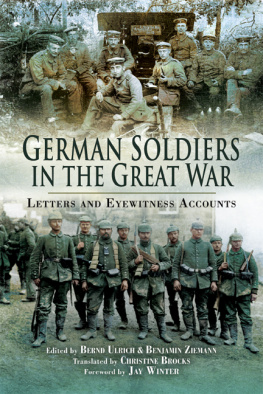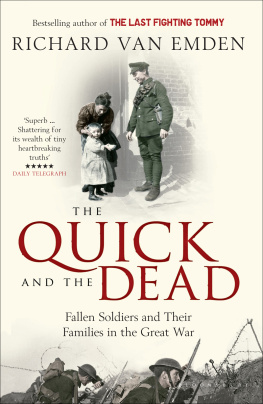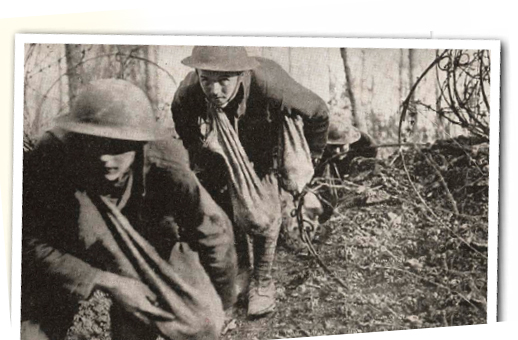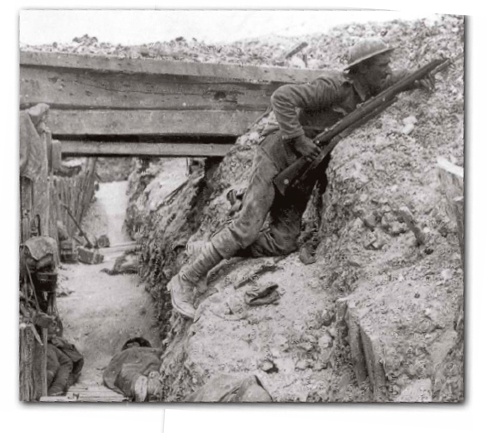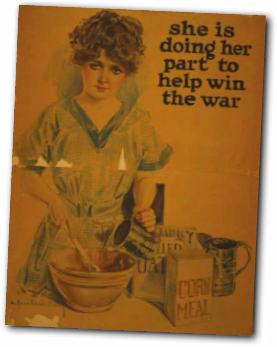
Please visit our website, www.garethstevens.com. For a free color catalog of all our high-quality books, call toll free 1-800-542-2595 or fax 1-877-542-2596.
Library of Congress Cataloging-in-Publication Data
Hunter, Nick.
World War I: frontline soldiers and their families / by Nick Hunter.
p. cm. (Frontline families)
Includes index.
ISBN 978-1-4824-3065-3 (pbk.)
ISBN 978-1-4824-3068-4 (6 pack)
ISBN 978-1-4824-3066-0 (library binding)
1. World War, 1914-1918 Juvenile literature.
2. World War, 1914 - 1918 Social aspects Juvenile literature.
I. Hunter, Nick. II. Title.
D522.7 H86 2016
940.3d23
First Edition
Published in 2016 by
Gareth Stevens Publishing
111 East 14th Street, Suite 349
New York, NY 10003
2016 Gareth Stevens Publishing
Produced by Calcium
Editors for Calcium: Sarah Eason and Rachel Warren Chadd
Designers: Paul Myerscough and Jessica Moon
Picture researcher: Susannah Jayes
Cover: Wikipedia Commons: Private Jim Rae; Inside: Shutterstock: Natasha Breen 14, Susan Law Cain 4, 10, 12, 40, Everett Collection 26, 38, Igor Golovniov 15tr, 44, Jeff Gynane 19b, Harris & Ewing 23, LiliGraphie 18, 28t, Jason Maehl 43b; Willequet Manuel 43t, Photoiconix 13, Elena Ray 7, Elzbieta Sekowska 19t, Slava2009 31, TonLammerts 21t, Max Voran 23b, Wikimedia Commons: 22, 39, Archiv Corps Masovia 29, Australian War Museum 17, British Library 25, City of Toronto Archives 41, Guy de Rambaud 15, Imperial War Museums 8, Jefferson Parish Library Archives 37, Library of Congress 6, 23, 30, 32, 33, 36, National Archives and Records Administration 21t, 35, 42, National Library of France 27, National Library of Scotland 24, PD-BritishGov 5b, Private Jim Rae 1, The India & Colonial Exhibition 5t, United Kingdom Government 34.
All rights reserved. No part of this book may be reproduced in any form without permission from the publisher, except by reviewer.
Printed in the United States of America
CPSIA compliance information: Batch #CS15GS: For further information contact Gareth Stevens, New York, New York at 1-800-542-2595.
CONTENTS
Chapter 1 World War I
Chapter 2 Fighting the War
Chapter 3 The Changing Role of Women
Chapter 4 Families at Home
Chapter 5 Victory and Defeat
Chapter 6 Recovery and Remembrance
Glossary
For More Information
Index
CHAPTER 1
WORLD WAR I
In the summer of 1914, Europe was plunged into a devastating war that would claim millions of lives and last for more than four years. This conflict, which people at the time called the Great War, did not just change the lives of the millions of men who fought in it. It also had a big impact on families and children who were often far from the front line.
A Global Conflict
The war was fought between Germany and Austria-Hungary on one side, which faced the combined armies of Great Britain, France, Russia, and their allies. As the conflict went on, other countries were dragged into it. Fighting spread to Asia and Africa. In 1917, the United States finally joined the war on the side of Great Britain, France, and their allies. It was now truly a world war.
Allied soldiers fighting bloody trench battles on the Western Front were later joined by US ground forces who helped to secure the final victory.
Primary Source: What Does It Tell Us?
This 1886 map shows the British Empire, which included all the countries shaded in blue, such as Australia, Canada, and India. Though far from Europe, they sent soldiers to fight for Britain. How do you think these men feltfighting in strange lands thousands of miles from their homes?
What Caused the War?
For a century before 1914, the nations of Europe had lived mostly in peace with each other, but rivalries and jealousies had built up. Prussia and many smaller states had united to form the mighty German Empire. Germany was a rival, not only to her neighbor France but also to the British Empire. Russia and Austria-Hungary were competing for power in Eastern Europe, but smaller countries, such as Serbia and Bosnia-Herzegovina, wanted to rule themselves.
A British soldier keeps watch from a trench in France.
When Archduke Franz Ferdinand, heir to the throne of Austria-Hungary, was shot by Serbian nationalists on June 28, 1914, the complex system of alliances and rivalries meant that, within a few weeks, most of Europe was at war.
A CHANGING WORLD
During World War I, life changed dramatically for families. Men left their families behind to prepare for battle, and women began working in jobs formerly carried out by men. This meant that many families were separated for long periods of time, and their lives changed forever.
Changes to Family Life
The war meant that childrens fathers were away on the front line and their mothers now worked in jobs away from the homeoften in military factories where they helped make ammunition for soldiers fighting in the war. With all efforts focused on sending supplies to the front line, certain foods, such as those made from wheat, were less available to families. Women had to change the way they worked, and the foods they cooked for their families.
Secondary Source: What Does It Tell Us?
Look at this poster from World War I. It shows a woman cooking with cornmeal, oats, and barley. The wording of the poster reads, she is doing her part to help win the war. What do you think this means? How might reducing the amount of wheat a family ate have helped the war effort? Explain your thinking.
This is a photograph of children playing around the time of World War I. How do you think life for these children would have changed during the war?
Wartime Childhood
Life for children became very different during World War I, compared with how it had been before the war. Children became responsible for many of the jobs that their mothers would previously have done at home. There was much less time to play because there were now many more daily chores to do.
Not only did the day-to-day lives of children in wartime families become physically harder, the children themselves became emotionally tougher, too. They had to deal with the threat that their fathers and brothers could be injured or even killed in battle. Families dreaded the arrival of a message by telegram or mail that told them that a father, brother, uncle, or cousin on the front line had been injured or killed.
Next page



